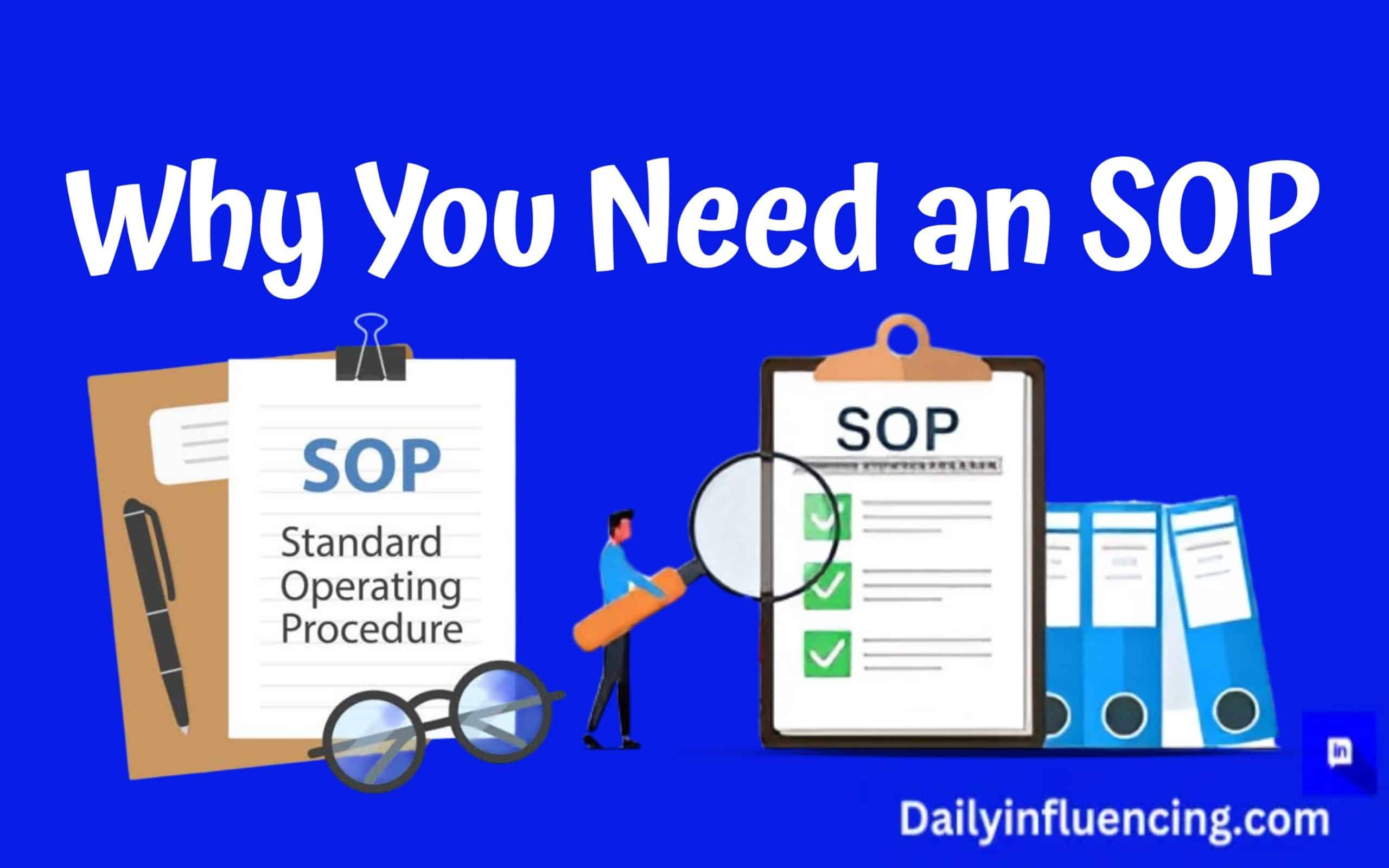
Creating an SOP is not just about crafting a document that will guide employees at work. It’s about maintaining value, consistency and quality.
As a small business owner still starting out, an SOP might sound like an idea that is not necessary for your business. But when these procedures are drafted from the start, it creates a culture of quality that guides your business during growth and expansion.
Therefore, this blog post is for small business owners who do not own an SOP.
By the end of this post, you’ll understand what an SOP is and why it’s important for maintaining quality and consistency in your organization.
What Is An SOP?
An SOP (Standard Operating Procedure) is a step-by-step instruction put together especially for repetitive tasks.
It explains exactly how to carry out specific tasks in an organization or company.
5 years ago, during my industrial training at an Air Force base, an SOP was handed to us on the first day of work.
We were two at the time, and while we were just beginners, the instructions for the different tests run in the laboratory helped us carry out these tests, too, under supervision.
Two months later, we had another intern, and the same process was done. She was handed the document and it had worked as a guide too.
That was my first time seeing the importance of having an SOP. It reduces redundancy and mistakes in the workplace.
No matter your organization or company, creating an SOP is a step towards building structure, reducing confusion and ensuring consistency in how tasks are carried out.
Let’s look at some of the main reasons why having a standard operating procedure (SOP) is essential for your small business.
Benefits Of Having A Standard Operating Procedure (SOP) In Your Business
Have you ever followed a guideline to perform a specific task or followed a recipe to cook a specific meal?
The first time I baked a cake, I had the ingredients listed out, their measurements and the instructions I needed to follow from a friend.
I applied each step of the baking process just like the recipe stated, and to my surprise, it turned out just like my friend’s cake.
This is the value of having a standard operating procedure.
Supports business growth and expansion.
As your business grows, things start becoming more complex. You have more products to manufacture, more customers to handle, and more employees to lead.
With a standard operating procedure drafted for important and repetitive tasks such as product manufacturing, customer service and employee behaviors, you can delegate tasks and responsibilities without incurring unnecessary mistakes.
Additionally, SOPs can be refined as your business needs change. However, creating a standard operating procedure makes it possible to maintain quality while growing or expanding.
Improves employee training process
One manager or team leader might not be able to personally train every single employee, especially as your business begins to grow. But with a well-crafted Standard Operating Procedure (SOP) in place, you can ensure that every team member receives the same guidance, no matter who’s leading the training. This kind of consistency is key to creating a unified workflow, reducing misunderstandings, and improving overall performance across the organization.
In addition, an SOP becomes a reliable point of reference for employees. Instead of relying on memory or interrupting someone else for clarity, they can revisit the document at any time to refine their approach or double-check the correct process. This not only empowers your team to work more independently but also helps maintain the quality and efficiency of their output.
Supports quality control and assurance
When processes are clearly documented, it’s easier to spot when something goes wrong. Creating a standard operating procedure (SOP) helps small businesses maintain consistent quality in their product or services. The main goal of an SOP is to ensure that every task is done the same way, regardless of who’s handling it.
Quality is one thing that draws customers to your business, and it’s the same thing that converts them to loyal customers. With an SOP in place, you can establish a benchmark for performance.
Promotes customer service
SOPs often include step-by-step solutions for common customer issues and inquiries. This makes it easier for your customer support team to know the best way to handle customer inquiries, complaints and feedback in a professional manner.
Therefore, it’s important to understand the positive effect an SOP has not just in streamlining internal processes but also delivering exceptional customer service.
Vital for operational excellence
An SOP helps to ensure that all team members are aligned in their approach and use the same best practices to work. This consistency minimizes errors and boosts productivity. With an SOP, employees know exactly what’s expected of them. This helps to reduce the guesswork that can lead to inefficiencies or mistakes. By establishing these standards early on, you’re laying the groundwork for long-term success and continuous improvement as your business grows.
How To Create An SOP
Now that you understand the benefits of an SOP, let’s look at how to create one for you business.
Understand the goal behind the SOP
Identify the purpose of creating the document. What process or task is it meant to document? Is it for customer inquiries, handling inventory or training employees? Understanding the goal is the first step to creating a specific, practical and useful document.
Choose a format
SOPs can come in various formats; checklists, flowcharts, or written procedures. Choose the one that best suits the task and your team’s needs. For more complex processes, a flowchart might be helpful. For simpler tasks, a straightforward checklist might be all you need.
Involve the right people
Don’t create the SOP alone. Collaborate with team members who are familiar with the process. They’ll offer insights that can make the procedure more accurate and practical. This also helps ensure that the SOP reflects the real-world workflow.
Document the process step-by-step- Create an SOP
Break the process down into clear, easy-to-follow steps. Include any necessary details, such as tools to use, timelines, or specific language to ensure clarity. Be as specific as possible to avoid any confusion later.
Review and test the SOP
Once you’ve drafted the SOP, have team members test it out to ensure it works. Testing is essential to iron out any potential issues and make improvements. Their feedback will help refine the document.
Revise and finalize
Make any necessary revisions based on feedback and testing. Once you’re satisfied, finalize the document and ensure it’s accessible to all employees who need it.
Implement and train team members
Share the SOP with your team and make sure they understand it. Offer training, if needed, to walk through the process and clarify any questions. Consistent training ensures that the SOP is effectively implemented.
Review and update regularly- Create an SOP
An SOP should be a continuous process. As processes evolve or your business grows, so should your SOPs. Schedule periodic reviews to make sure they remain relevant and effective.
Conclusion
Having an SOP for your small business is something every business owner should have. In fact, it’s essential for keeping things organized, making training easier, and ensuring tasks get done the right way every time, even when you’re not around.
Moreover, creating an SOP doesn’t have to be complicated. Start by writing down your main processes, then break them into simple, easy-to-follow steps. As you go, you’ll find that the time spent upfront pays off in the long run, making your operations more efficient and reducing confusion. Ultimately, an SOP is a smart investment that will help your business run smoothly, save time, and grow more effectively.




